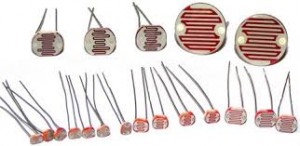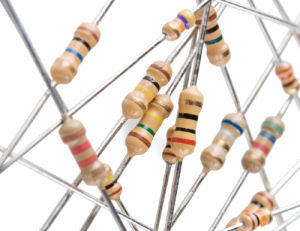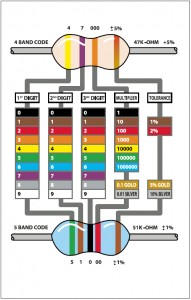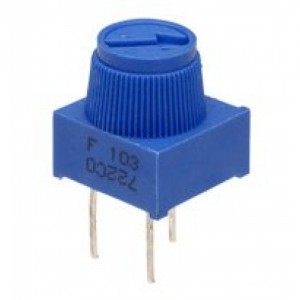So far all of our numbers have worked out perfect we needed 6 V to light up two green LEDs, but this is not always the case. Just like when you learned division in school they always had you come out with round numbers. Ex 9 ÷3=3 but now its time to learn what happens if you want to power a 1.7V Red LED with a 3V battery. You need to add some resistance, aka slow down the electricity so it doesn’t burn out your LED!
Instead of using play dough for resistance we will use:
Resistors – Resistors are extremely common in all your devices they Resistors have one job to do, and that is to resist the flow of electricity (otherwise known as current).
The video shows a tripped circuit breaker well we don’t use circuit breakers but you will hurt your LED with out using the proper resistance. And it will never work again :^(
The electrical resistance of a resistor is measured in ohms. The symbol for an ohm is the greek capital-omega: Ω.
larger or smaller values of ohms can be matched with a prefix like kilo-(1000), mega-(1,000,000) to make large values easier to read. It’s very common to see resistors in the kilohm (kΩ) and megaohm (MΩ) range. For example, a 4,700Ω resistor is equivalent to a 4.7kΩ resistor, and a 5,600,000Ω resistor can be written as 5,600kΩ or (more commonly as) 5.6MΩ.
So many sizes shapes and colors and their is a code to read them by:
Show them a few and how to read them
Show them the adafruit calculator (circuit Playground) or online
But what size do I need? The answer is ohm’s law
Voltage(V) = Current(I)X Resistance(R)
or
Resistance(R) = Voltage (V)/Current(I)
Voltage is figured out with (battery Voltage – LED Voltage) and we will assume I (current) is .02 amps
R = (Vs – Vf) / If
3.5V – Violet
3.2V – 3.4V – Blue
3.5V – Aqua
2.6V – Green
2.1V – Yellow
2.2V – orange
1.7V – Red
3.2V – White
For this class will always use .02 A
So for a red led (chart) and a 5 V battery what do I need?
R=(5-1.7)/.02
R=(3.3)/.02
165Ω
Or just use the calculator
For this class we should require no higher than a 165 Ω can anyone find this in the pile?
Explain why.
Other types of resistors
Photoresistor (must use with regular resistor) – Light dependent resistor. Phontons hitting the resister allow electricity to pass. Resistance decreases as more light hits the photoresistor must use with resistor.
Potentiometer (variale resistance turn the known to change) must use with resistor. Most Potentiometers have three leads. the center is the ‘wiper’. turning the knob moves the wiper between the other tow leads.
pressure sensitive resistors (like in your shoes) use resister (Use a regular resistor with these)
Activity:
1. Find the resistance of the 3 resistors in front of you Hint: use the chart or use the calculator
2. Hook each one up to the LED and see what happens what happens with different ones?
3. Try adding a photoresistor to your circuit and see what it does.
4. Use the potentiometer to turn up and down the brightness of your LED
Longer term projects – pressure sensitive – things get touched light goes on, Box that when opened the photoresistor lights the led (great for lockers)……endless!



